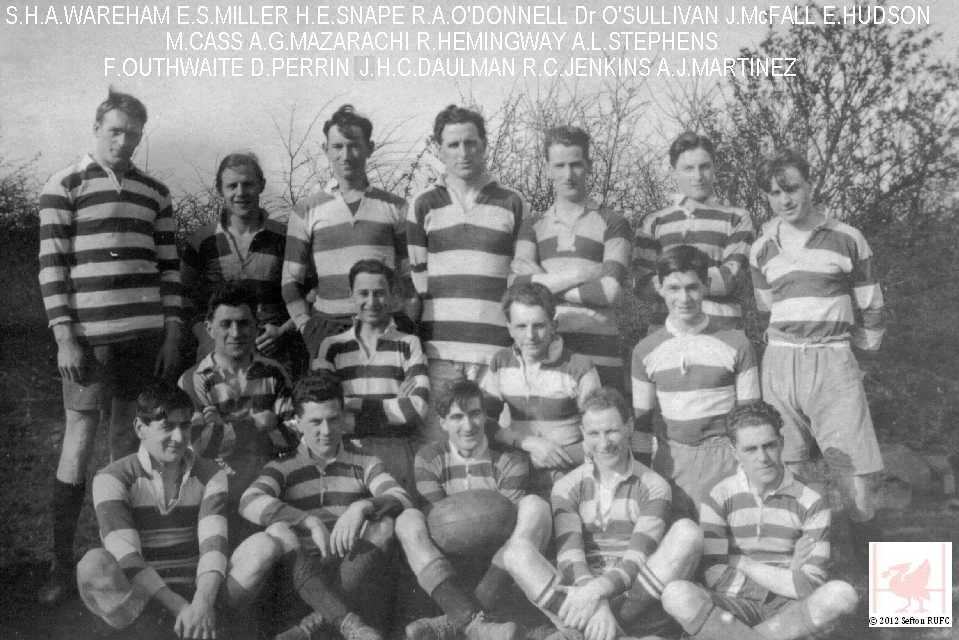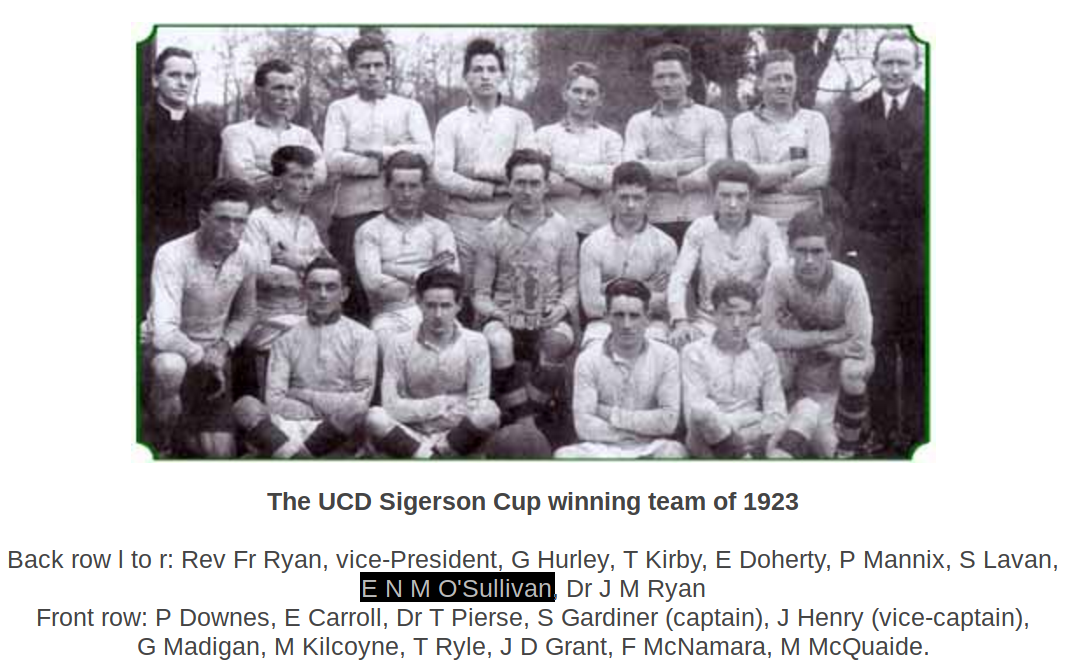Written and researched by David
Bohl,
with the kind help of historians world wide.
Played
1920-21

Back
Row S.H.A.WAREHAM E.S.MILLER H.E.SNAPE
R.A.O'DONNELL
Dr
O'SULLIVAN
J.McFALL E.HUDSON
Middle
Row M.CASS A.G.MAZARACHI R.HEMINGWAY
A.L.STEPHENS
Front
Row F.OUTHWAITE D.PERRIN H.C.F.DAULMAN
R.C.JENKINS
A.J.MARTINEZ
KEEN
GAME AT WEST DERBY.
Bidston
beat Sefton A in a hard-fought game on
the latter's
ground by a goal and two tries (11 points) to a try (3 points). In the
first half Sefton were superior in attack and Perrin scored a try.
There would have been more scoring but for some resolute tackling by
Parry, the Bidston full-back. In the second half, however, Bidston
improved, and tries were scored by Galloway, Price, and Woodward, the
latter also converting.
The
visiting three-quarters were a better lot
than Sefton's
in that their handling was much superior and their running stronger,
while Price and Poe showed a good understanding. Among the forwards
Pavillard, A. Taylor and Cooper were prominent. Dr.
O'Sullivan, at
full-back for Sefton, played a sterling game, and in the second half
undoubtedly saved his side from defeat. Bayliss gave his rear division
the ball on numerous occasions, only to see it lost through faulty
handling. The home forwards were outplayed in the loose, but worked
hard, especially Perrin and Ledger. During the scrums the ball was
rarely brought out cleanly, a general fault of second-class rugger.
Teams.-Sefton
A: Dr.
O'Sullivan; Thompson, Millington, Hudson, Davey; Bayliss, M'Gibbon;
Ledger, Perrin. Williams, J. A. Cass, Rimmer, Mackenzie, Martinez,
Jenkins.
Bidston-Parry;
Burns, Ellam,
Woodward, Galloway;
Price, Poe;
Cooper, Hudson, Pavillard. Williams, Rylls, H. Taylor, A. Taylor,
Hinson.
Result:-
Bidston 11 points, Sefton A. 3 points.
Daily
Post 4/4/21
Dr
O'Sullivan's Casebook is firmly locked at present with scant details to
identify him. The Committee Minutes have left us with just three
possible keys.
Committee
Meeting held at Hare and Hounds Hotel, West Derby 20.1.21
The
following new members were elected.
| Dr
O'Sullivan |
proposed
|
Dr
Rumjahn |
seconded
|
J.H.Helme
|
Committee
Meeting held at
Hare and Hounds Hotel November 25th
1921
The
resignations of the following were accepted
Dr
O'Sullivan (returned to
Ireland)
The
resignation
of Dr O'Sullivan was accepted
with real regret.
To summarise, he was an Irish doctor, arrived in January 1921, departed
in say December of that year and was held in high esteem by
members of the club.
Throughout his association with the Sefton he is always referred to as
plain "Dr O'Sullivan", no first name at all, did he prefer running
almost incognito ?
The dates are extremely significant in terms of the volatile politics
of Ireland, especially for the medical profession, in the post-WW1
period.
A few chapters of a book entitled "Medicine, Health and Irish
Experiences of Conflict 1914-45" set out the problems that may have
encompassed him.
[Civilian
doctors who had
not participated in the war often admitted that they were not au fait
with the treatment of gunshot wounds. In May 1919, Dan Breen, Ned
O'Brien and Jimmie Scanlon, three members of the IRA's East Limerick
Brigade, were shot and wounded while rescuing another member of their
brigade from the Royal Irish Constabulary (RIC). A local doctor,
William Hennessy, was sent for to treat the wounded. Hennessy arrived
and, after finishing his treatment, admitted that he had 'done his best
for the wounded men but that he did not know very much about wounds'.
Breen subsequently required further medical treatment from other
doctors.
While
the IRA
sought the medical experience of doctors who had been in the British
Army medical services, their assistance was not always offered.
Although some held sympathy for republicanism, others were staunchly
attached to the Union and may have deplored the levels of violence
being used to secure national independence. On 15 February 1921, the
IRA attacked a train carrying British soldiers at Upton, Co. Cork. The
train was carrying approximately fifty soldiers of the Essex Regiment.
During the shoot-out on the train, two IRA volunteers were killed, one
was fatally wounded and two others were badly wounded. The local
dispensary doctor in Enniskean refused to attend the Brigade OC and the
other wounded men. The IRA arrested the doctor, who is listed in the
1921 Medical Directory as Dr T. J. Coakley, and tried him by
court-martial. They found him guilty and ordered
that he leave
Ireland
within twenty-four hours.
Coakley departed to
Liverpool.
The Irish Civil
War, 1922-23
While
ex-RAMC doctors'
role in the War of Independence was somewhat secretive and carried out
under the radar of the British Army and RIC, their involvement in the
Irish Civil War was official and publicly recognised. During the
interwar years
Irish doctors continued to enlist in the RAMC. However, for those
who
wished to return to Ireland,
there was an opportunity to
continue their
army work in the newly formed Irish National Army. Established in
January 1922, it was the official army of the Irish Free State and
operated under the control of Michael Collins, its Chief of Staff until
his death in August 1922]
A likely candidate may be Dr Éamon
O’Sullivan(1896-1966) who was involved with Gaelic football
in
the 1920's. The Kerryman, known as ‘The Doc’,
trained his
native county to eight All-Ireland titles over five decades (1924,
1926, 1937, 1946, 1953, 1955, 1959 and 1962).
[Photo
and narrative from UCD and the
Sigerson by Irial Glynn]
Perhaps
when the 1921 Census is
published more will come to
light.
All
Aliens RFC, Seft0n
RUFC
photographs, programmes and memorabilia Copyright © 2012
Sefton RUFC



